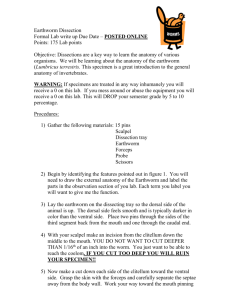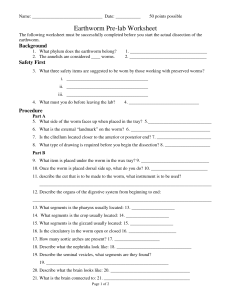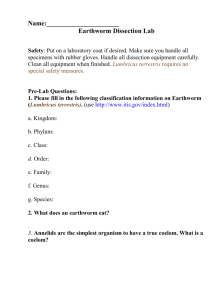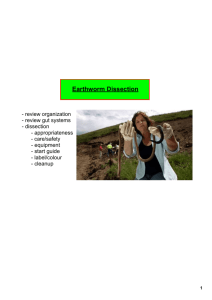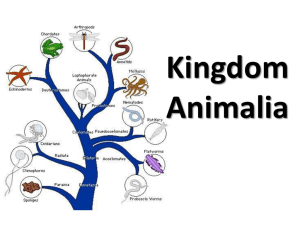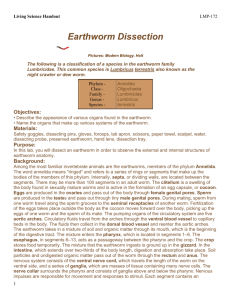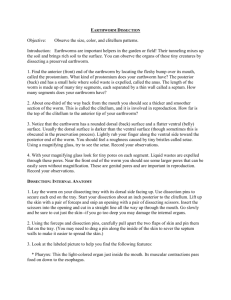Earthworm Dissection
advertisement
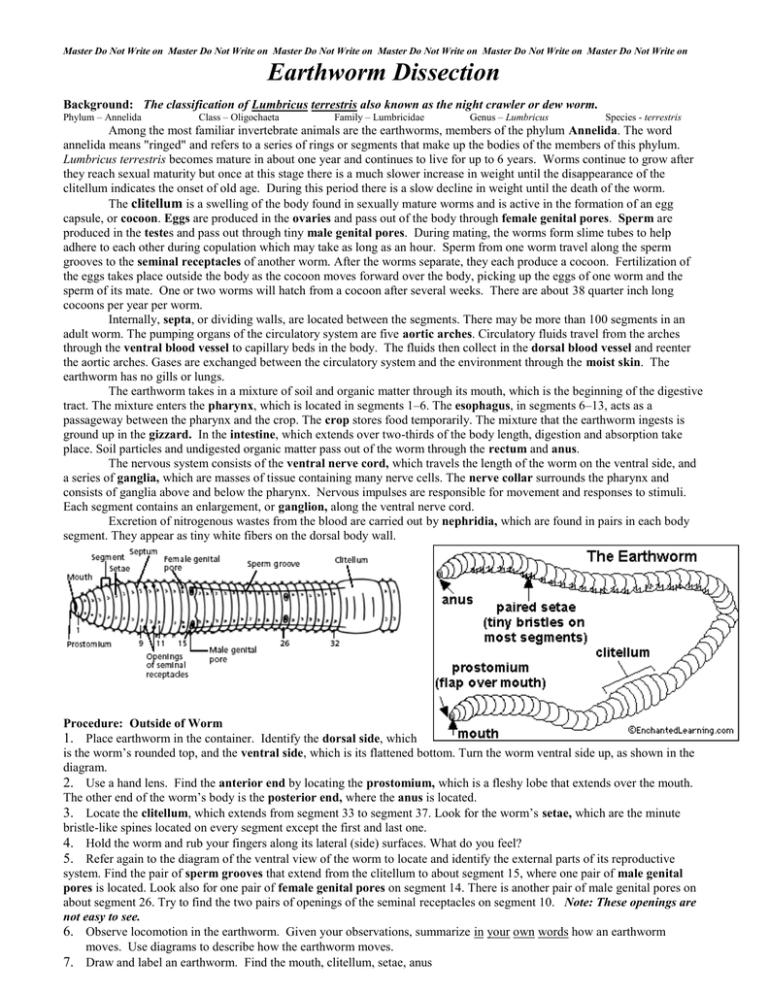
Master Do Not Write on Master Do Not Write on Master Do Not Write on Master Do Not Write on Master Do Not Write on Master Do Not Write on Earthworm Dissection Background: The classification of Lumbricus terrestris also known as the night crawler or dew worm. Phylum – Annelida Class – Oligochaeta Family – Lumbricidae Genus – Lumbricus Species - terrestris Among the most familiar invertebrate animals are the earthworms, members of the phylum Annelida. The word annelida means "ringed" and refers to a series of rings or segments that make up the bodies of the members of this phylum. Lumbricus terrestris becomes mature in about one year and continues to live for up to 6 years. Worms continue to grow after they reach sexual maturity but once at this stage there is a much slower increase in weight until the disappearance of the clitellum indicates the onset of old age. During this period there is a slow decline in weight until the death of the worm. The clitellum is a swelling of the body found in sexually mature worms and is active in the formation of an egg capsule, or cocoon. Eggs are produced in the ovaries and pass out of the body through female genital pores. Sperm are produced in the testes and pass out through tiny male genital pores. During mating, the worms form slime tubes to help adhere to each other during copulation which may take as long as an hour. Sperm from one worm travel along the sperm grooves to the seminal receptacles of another worm. After the worms separate, they each produce a cocoon. Fertilization of the eggs takes place outside the body as the cocoon moves forward over the body, picking up the eggs of one worm and the sperm of its mate. One or two worms will hatch from a cocoon after several weeks. There are about 38 quarter inch long cocoons per year per worm. Internally, septa, or dividing walls, are located between the segments. There may be more than 100 segments in an adult worm. The pumping organs of the circulatory system are five aortic arches. Circulatory fluids travel from the arches through the ventral blood vessel to capillary beds in the body. The fluids then collect in the dorsal blood vessel and reenter the aortic arches. Gases are exchanged between the circulatory system and the environment through the moist skin. The earthworm has no gills or lungs. The earthworm takes in a mixture of soil and organic matter through its mouth, which is the beginning of the digestive tract. The mixture enters the pharynx, which is located in segments 1–6. The esophagus, in segments 6–13, acts as a passageway between the pharynx and the crop. The crop stores food temporarily. The mixture that the earthworm ingests is ground up in the gizzard. In the intestine, which extends over two-thirds of the body length, digestion and absorption take place. Soil particles and undigested organic matter pass out of the worm through the rectum and anus. The nervous system consists of the ventral nerve cord, which travels the length of the worm on the ventral side, and a series of ganglia, which are masses of tissue containing many nerve cells. The nerve collar surrounds the pharynx and consists of ganglia above and below the pharynx. Nervous impulses are responsible for movement and responses to stimuli. Each segment contains an enlargement, or ganglion, along the ventral nerve cord. Excretion of nitrogenous wastes from the blood are carried out by nephridia, which are found in pairs in each body segment. They appear as tiny white fibers on the dorsal body wall. Procedure: Outside of Worm 1. Place earthworm in the container. Identify the dorsal side, which is the worm’s rounded top, and the ventral side, which is its flattened bottom. Turn the worm ventral side up, as shown in the diagram. 2. Use a hand lens. Find the anterior end by locating the prostomium, which is a fleshy lobe that extends over the mouth. The other end of the worm’s body is the posterior end, where the anus is located. 3. Locate the clitellum, which extends from segment 33 to segment 37. Look for the worm’s setae, which are the minute bristle-like spines located on every segment except the first and last one. 4. Hold the worm and rub your fingers along its lateral (side) surfaces. What do you feel? 5. Refer again to the diagram of the ventral view of the worm to locate and identify the external parts of its reproductive system. Find the pair of sperm grooves that extend from the clitellum to about segment 15, where one pair of male genital pores is located. Look also for one pair of female genital pores on segment 14. There is another pair of male genital pores on about segment 26. Try to find the two pairs of openings of the seminal receptacles on segment 10. Note: These openings are not easy to see. 6. Observe locomotion in the earthworm. Given your observations, summarize in your own words how an earthworm moves. Use diagrams to describe how the earthworm moves. 7. Draw and label an earthworm. Find the mouth, clitellum, setae, anus Master Do Not Write on Master Do Not Write on Master Do Not Write on Master Do Not Write on Master Do Not Write on Master Do Not Write on Materials: Earthworm, dissecting pins, forceps, scissors, scalpel/razor, water, dissecting probe/toothpick, hand lens, dissection tray. Purpose: In this lab, you will dissect an earthworm in order to observe the external and internal structures of earthworm anatomy. 1. Turn the worm dorsal side up. Pin the worm to the tray at the anterior (mouth) and posterior (anus) ends. 2. Measure about 2 cm. behind the clitellum; make a small horizontal cut in the body wall. This will allow you to place the scissor's/razor’s point into the body cavity (coelom) . Now cut upward and forward (anterior), until you reach the end (mouth) of the worm. 3. You will notice that the body wall of the worm will not move down into a flattened position. It is being held in position by small internal walls called septa. These septa must be cut in order for the body wall to lay flat. Use your probe to break these septa. 4. Use the diagram below to locate and identify the five pairs of aortic arches, or hearts. Then find the dorsal blood vessel. Look for smaller blood vessels that branch from the dorsal blood vessel. 5. Locate the digestive tract, which lies below the dorsal blood vessel. Refer to the diagram above to locate the pharynx, esophagus, crop, gizzard, and intestine. 6. To find organs of the nervous system, push aside the digestive and circulatory system organs. Use the diagram below to locate the ventral nerve cord. Trace the nerve cord forward to the nerve collar, which circles the pharynx. Find one pair of ganglia under the pharynx and another pair of ganglia above the pharynx. The ganglia above the pharynx serve as the brain of the earthworm. 7. The worm’s excretory organs are tiny nephridia. There are two in every segment. Use the preceding diagram to locate some nephridia. 8. Use the diagram below to locate and identify a pair of ovaries in segment 13. Look for two pairs of tiny testes in segments 10 and 11. To find these organs, you will again have to push aside some parts already dissected. 9. Dispose of your materials according to the directions from your teacher. 10. Clean up your work area, dry dissection materials, and wash your hands before leaving the lab. Analysis: 1. What is the name of the pumping organs of the circulatory system of an earthworm? 2. Trace (describe) the parts of the digestive tract through which food passes. 3. Which parts of the earthworm serve as its brain? How are these parts connected to the rest of the body? 4. Which of the parts of the worm’s body that you saw are included in the excretory system? 5. How can you find out whether an earthworm eats soil? 6. How is the earthworm’s digestive system adapted for extracting relatively small amounts of food from large amounts of ingested soil? 7. What macromolecules are digested, and what enzymes must be present for this digestion to occur? 8. Your dissection of the earthworm did not go beyond segment 32. What will you observe if you dissect the remainder of the worm to its posterior end? 9. On a separate piece of paper, draw and label the parts of the dissected earthworm you observed, and color code the systems. Use green for the reproductive system, yellow for the digestive system, blue for the excretory system, and red for the nervous system.
